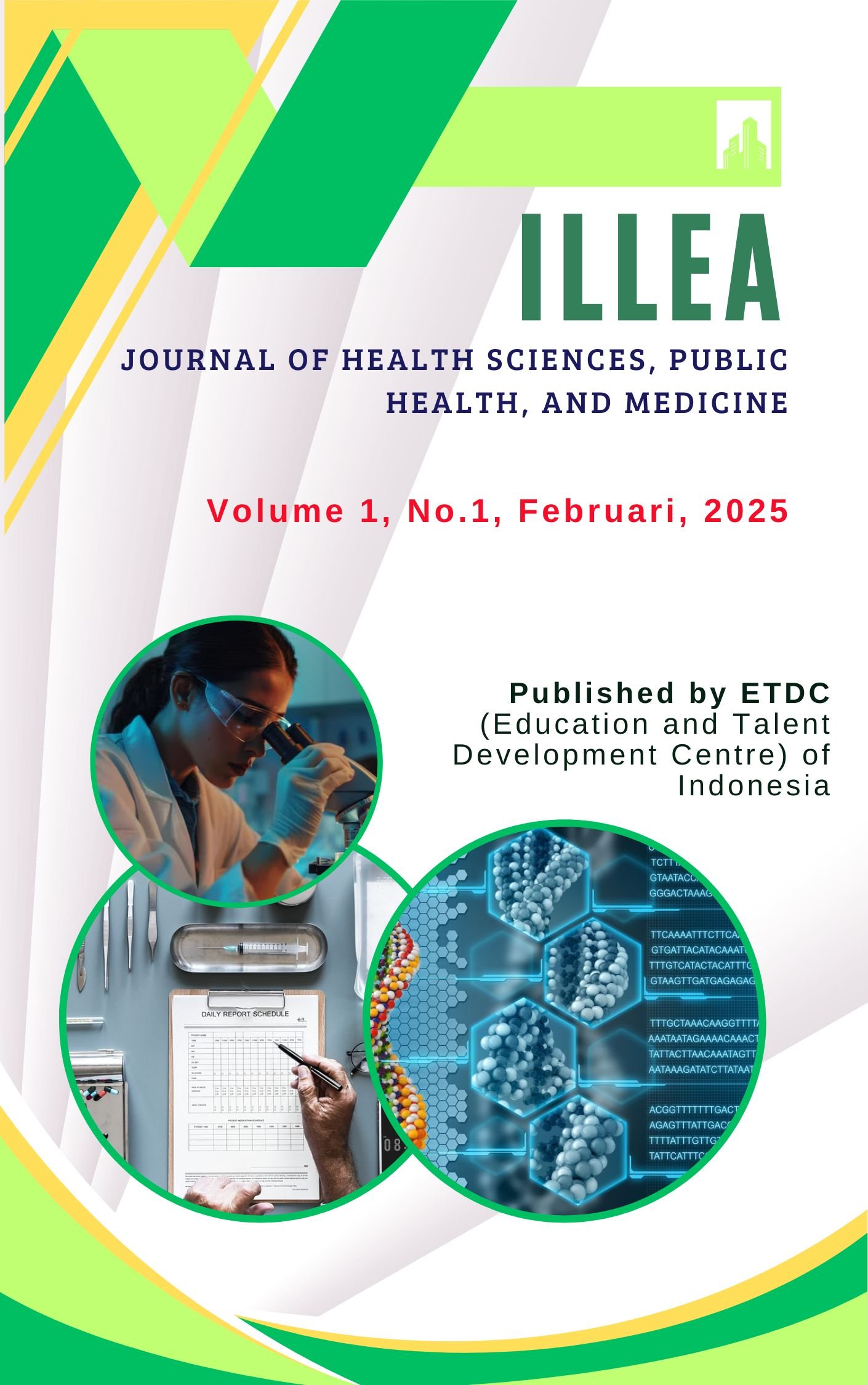A review: Biosintesis Nanopartikel dari Limbah Minyak Jelantah untuk Aplikasi Lingkungan dan Kesehatan
Keywords:
Vanadium, Senyawa Kompleks, Koordinasi, Agen TerapautikAbstract
Degradasi lingkungan merupakan isu yang terus berkembang, mendorong para peneliti untuk mengembangkan metode sintesis nanopartikel (NP) yang ramah lingkungan untuk berbagai aplikasi. Dalam konteks ini, pemanfaatan limbah minyak jelantah (UCO) sebagai sumber hijau dalam sintesis NP telah muncul sebagai alternatif yang menjanjikan dibandingkan teknik konvensional. Industri makanan menghasilkan limbah minyak jelantah dalam jumlah besar, yang sebagian besar tidak dapat dibuang begitu saja tanpa pengolahan lebih lanjut. Tinjauan ini mengevaluasi sintesis hijau NP berbasis UCO serta potensi aplikasinya dalam bidang lingkungan dan kesehatan, dengan mengidentifikasi tantangan utama serta prospek penelitian masa depan. Prinsip dan metode sintesis NP hijau turut dianalisis, dengan penekanan pada sifat unik UCO sebagai agen reduksi dan stabilisasi yang efektif, serta teknik karakterisasi yang digunakan untuk menganalisis NP yang dihasilkan. NP berbasis UCO memiliki berbagai aplikasi lingkungan, termasuk dalam pemurnian air, degradasi polutan, dan remidiasi area yang terkontaminasi. Dalam sektor kesehatan, NP ini berperan dalam sistem penghantaran obat, memiliki aktivitas antimikroba, serta digunakan dalam terapi kanker. NP berbasis UCO telah terbukti efektif dalam meningkatkan efisiensi penghantaran obat ke sel kanker, sehingga dapat meningkatkan keberhasilan terapi sekaligus mengurangi potensi efek samping. Namun, diperlukan evaluasi toksisitas yang komprehensif, terutama dalam penggunaan NP pada konsentrasi tinggi, guna memastikan keamanannya dalam berbagai aplikasi.
References
Amini, S. M. (2019). Gold nanoparticles for drug delivery systems. Materials Science and Engineering: C, 93, 392-400. https://doi.org/10.1016/j.msec.2018.08.061
Anandalakshmi, K., Venugobal, J., & Ramasamy, V. (2016). Characterization of silver nanoparticles by green synthesis method using Pedalium murex leaf extract and their antibacterial activity. Applied Nanoscience, 6(3), 399-408. https://doi.org/10.1007/s13204-015-0449-z
Basavegowda, N., & Idhayadhulla, A. (2020). Plant-mediated green synthesis of metal nanoparticles and their biological applications. New Journal of Chemistry, 44(16), 6801-6810. https://doi.org/10.1039/C9NJ06341C
Chen, X., & Schluesener, H. J. (2008). Nanosilver: A nanoproduct in medical application. Toxicology Letters, 176(1), 1-12. https://doi.org/10.1016/j.toxlet.2007.10.004
Dhand, C., Dwivedi, N., Loh, X. J., Ying, A. N. J., Verma, N. K., Beuerman, R. W., & Lakshminarayanan, R. (2015). Methods and strategies for the synthesis of diverse nanoparticles and their applications: A comprehensive overview. RSC Advances, 5(127), 105003-105037. https://doi.org/10.1039/C5RA19388E
El-Rafie, H. M., & Hamed, M. A. (2014). Antimicrobial activity of green synthesized silver nanoparticles using polysaccharides. Carbohydrate Polymers, 113, 86-93. https://doi.org/10.1016/j.carbpol.2014.06.077
Ghorbani, H. R. (2019). Biosynthesis of nanoparticles: Green synthesis of silver nanoparticles using extracts of wild plants. Applied Biochemistry and Biotechnology, 187(1), 56-79. https://doi.org/10.1007/s12010-018-2830-z
Gopinath, V., Priyadarshini, S., Loke, M. F., Arunkumar, R., Marsili, E., MubarakAli, D., & Alharbi, N. S. (2020). Biogenic synthesis, characterization of antibacterial silver nanoparticles and evaluation of its toxicity in zebra fish embryos. Microbial Pathogenesis, 139, 103916. https://doi.org/10.1016/j.micpath.2019.103916
Gurunathan, S., Han, J. W., Kwon, D. N., & Kim, J. H. (2014). Enhanced antibacterial and anti-biofilm activities of silver nanoparticles against Gram-negative and Gram-positive bacteria. Nanoscale Research Letters, 9, 373. https://doi.org/10.1186/1556-276X-9-373
Hussein, M. Z., Zainal, Z., Yahaya, A. H., & Foo, D. W. (2005). Controlled release of a plant growth regulator, α-naphthaleneacetate, from the lamellar nanocomposite zinc-aluminium-layered double hydroxide. Journal of Controlled Release, 107(2), 299-308. https://doi.org/10.1016/j.jconrel.2005.06.016
Iravani, S. (2011). Green synthesis of metal nanoparticles using plants. Green Chemistry, 13(10), 2638-2650. https://doi.org/10.1039/C1GC15386B
Jain, D., Daima, H. K., Kachhwaha, S., & Kothari, S. L. (2009). Synthesis of plant-mediated silver nanoparticles using papaya fruit extract and evaluation of their antimicrobial activities. Digest Journal of Nanomaterials and Biostructures, 4(3), 557-563.
Jo, Y. K., Kim, B. H., & Jung, G. (2009). Antifungal activity of silver ions and nanoparticles on phytopathogenic fungi. Plant Disease, 93(10), 1037-1043. https://doi.org/10.1094/PDIS-93-10-1037
Kharissova, O. V., Dias, H. V. R., Kharisov, B. I., Pérez, B. O., & Pérez, V. M. (2013). The greener synthesis of nanoparticles. Trends in Biotechnology, 31(4), 240-248. https://doi.org/10.1016/j.tibtech.2013.01.003
Kim, J. S., Kuk, E., Yu, K. N., Kim, J. H., Park, S. J., Lee, H. J., ... & Cho, M. H. (2007). Antimicrobial effects of silver nanoparticles. Nanomedicine: Nanotechnology, Biology and Medicine, 3(1), 95-101. https://doi.org/10.1016/j.nano.2006.12.001
Logeswari, P., Silambarasan, S., & Abraham, J. (2013). Synthesis of silver nanoparticles using plants extract and analysis of their antimicrobial property. Journal of Saudi Chemical Society, 17(2), 203-208. https://doi.org/10.1016/j.jscs.2012.04.007
Mahapatra, O., Bhagat, M., & Gopalakrishnan, C. (2008). Green synthesis of silver nanoparticles using Ocimum sanctum (Tulsi) leaf extract and screening its antimicrobial activity. Materials Letters, 62(29), 4247-4250. https://doi.org/10.1016/j.matlet.2008.06.051
Rai, M., Yadav, A., & Gade, A. (2009). Silver nanoparticles as a new generation of antimicrobials. Biotechnology Advances, 27(1), 76-83. https://doi.org/10.1016/j.biotechadv.2008.09.002
Singh, M., Kalaivani, R., Manikandan, S., & Kumaraguru, A. K. (2013). Facile green synthesis of silver nanoparticles using aqueous extract of Turbinaria ornata and its antibacterial activity. Spectrochimica Acta Part A: Molecular and Biomolecular Spectroscopy, 106, 182-189. https://doi.org/10.1016/j.saa.2012.12.084
Sun, Q., Cai, X., Li, J., Zheng, M., Chen, Z., Yu, X., & Zhang, Y. (2014). Green synthesis of silver nanoparticles using tea leaf extract and evaluation of their stability and antibacterial activity. Colloids and Surfaces A: Physicochemical and Engineering Aspects, 444, 226-231. https://doi.org/10.1016/j.colsurfa.2013.12.036



